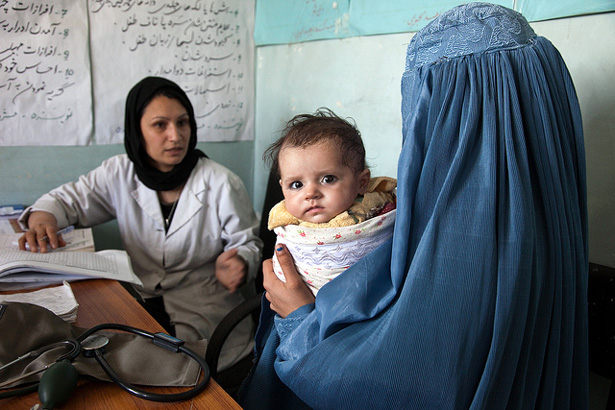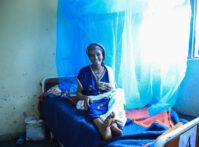-
In Afghanistan, Women’s Health May Be Marker for Taliban Resurgence [Part Two]
July 26, 2013 By Swara Salih
Afghanistan’s youth, including more than seven million girls currently in school, are leading the call for new leadership, but many Afghans fear the chilling effect of a resurgent Taliban, said panelists at the Wilson Center during the second half of “Afghanistan Beyond the Headlines.” As the United States prepares to withdraw its forces over the next year, a halt in the country’s progress on women’s health may be the first sign of backsliding on many of the gains made over the last decade. [Video Below]
In the last few years, religious rhetoric against many progressive efforts – such as the Elimination of Violence Against Women Law – has notably increased, said Palwasha Kakar, the director of women’s empowerment and development at the Asia Foundation. “We’ve been noticing that men are becoming more and more vocal about women’s clothes, mobility, and there’s been lots of threats towards women who are participating publicly,” she said. This past June, for example, the Afghan parliament removed a legal requirement that women have to make up at least a quarter of provincial elected officials.
From Worst to…Better
“Afghanistan has one of the highest maternal mortality and child mortality rates in the world,” said Ayscha Hamdani, former special adviser and chief of staff to the European Union special representative to Afghanistan. In 2010, the World Bank estimated that 460 women died per 100,000 live births, which is the 22nd highest rate in the world and the 2nd highest outside of sub-Saharan Africa.
Ratha Loganathan, senior Afghanistan health officer at USAID’s Office of Afghanistan and Pakistan Affairs, explained how lack of infrastructure exacerbates high child and maternal mortality rates. “Two-thirds of the women still give birth at home without a midwife or a skilled birth attendant,” she said. “One in thirteen children dies before their first birthday; one in ten children dies before the age of five; and one Afghan woman dies from pregnancy-related causes every two hours.”
USAID’s work since 2002 has therefore been focused on developing these health services, she said:
The health portfolio has empowered women and female health workers at all levels. At the local level more than 7,500 women health workers have been trained, including 3,000 midwives. USAID’s assistance has established a national network of midwifery schools, and as a result, average use of prenatal care has climbed to nearly 40 percent in provinces with midwifery school graduates, compared to 26 percent in provinces that lack such graduates.
“The results of these efforts are remarkable,” said Loganathan. They have contributed to a decline in maternal mortality of 1,600 per 100,000 births to 327; growth in use of modern contraceptives from 10 to 20 percent; decline in total fertility rate from 6.3 to 5.1 children per woman; increase in women reporting at least one antenatal care visit from just 16 percent of the population in 2003 to 60 percent in 2013; and double the use of skilled birth attendants.
In 2012, the country’s first-ever nationally representative survey of demographic and health issues reported major improvements from previous estimates, including a maternal mortality ratio of 327 women per 100,000 live births, nearly a 30 percent decline from 2010 estimates.
Dr. Linda Bartlett, a researcher on Afghanistan from the Johns Hopkins Bloomberg School of Public Health, emphasized that getting communities involved in the selection of women health workers has been crucial to the successes of the last decade. “Local community-based recruitment of health personnel has been very successful…communities are identifying a woman who they trust and they respect, and who commits by signing a document saying that she will go back to that community and provide health services,” she said.
In the Name of Islam
If these improvements are to continue, however, Kakar suggested more engagement with religious leaders may be needed. “The key with engaging men is finding credible ways to engage with them and really engaging with them, not using them,” she said. “We’ve seen a lot of success in engaging men through credible religious leaders by using Islamic frameworks.”
Hamdani said that for the sustainability of women’s health programs – and international development programs in general – it’s important to work within Afghanistan’s cultural parameters. “We ought to use the very religion of Islam, that is currently being used against women, to actually reinforce the position of women,” she said, “Let’s talk about the rights that woman have according to Islam and use this in a positive manner, to give women a greater access to education, to health, and to the basic provisions that they require.”
This kind of engagement is especially crucial as the Taliban appear to be growing bolder. As the Taliban enter southern and eastern Afghanistan, they’re seeing an “ideological war in some of these provinces,” Kakar said:
These Taliban have been starting something we’ve called a “Ramadan initiative.” Two months before Ramadan, they start holding sessions where they talk about religion in the mosques and they invite men and women to come and listen to these. By talking about verses from the Qur’an they try and justify their ideologies that are against a lot of work that civil society has been doing in terms of civic awareness, women’s education, women’s access to health, and women’s access to justice services.
Many Afghans take what the Taliban say seriously, and Kakar believes that may contribute to a recent uptick in Islamist rhetoric. A 2012 Asia Foundation survey found that 69 percent of Afghans think religious leaders should be consulted about local problems, she said. And a 2013 Pew Research Center poll found that 99 percent of Afghans interviewed are in favor of Sharia – traditional Islamic law – as the “official law of the land.” Kakar noted that even some women have protested the Elimination of Violence Against Women Law, which engendered such furious argument in May that Parliament had to stop debate on it after only 15 minutes. In 13 out of 18 provinces, at least 80 percent of women fear for their personal safety, she said.
Can An Empowered Generation Make the Difference?
Despite these challenges, panelists were largely optimistic about the future. “If [the international community makes] the mistake they did 20 years ago, and leave[s] Afghanistan by itself in the hands of our neighbors, who are not so friendly with us, I think the risks are high that we may lose the achievements we have made so far,” said Counterpart International’s Maiwand Rahyab. “But if they stay committed, engaged, and support the Afghan people, I think Afghanistan is [moving] in the right direction. Now with the level of civic activism and engagement in Afghanistan I think we are able to sustain the achievements.”
Hamdani emphasized the importance of empowering Afghanistan’s young girls – and boys – to take responsibility for the welfare of their country. “We need to place the responsibility where it belongs, and that is with the Afghan people,” she said:
Let’s build the capacity of the young Afghan people to actually own these processes, thereby you create accountability, you create ownership, and processes start manifesting themselves within Afghan society. I believe the sooner we start understanding that and the sooner we start relying on these processes, the sooner we can counter current brain drain that is going on in Afghanistan yet again.
“I think that the momentum in Afghanistan is such that it’s not going to go back to where it was in the previous era, but it’s not going to be easy either,” said Bartlett.
“I can’t emphasize more the importance of education for young men and women,” said Rahyab. “Access to quality and equitable education…will transform Afghanistan. It already has. Contrary to the conventional perceptions, Afghanistan is on the right path toward development and democracy, and supporting youth engagement is central to the success of this journey.”
Event Resources:
- Dr. Linda Bartlett’s Presentation
- Ayscha Hamdani’s Keynote Address
- Palwasha Kakar’s Presentation
- Ratha Loganathan’s Presentation
- Photo Gallery
- Video
Sources: Asia Foundation, The Guardian, Pew Research Center, The New York Times, Reuters, World Bank.
Photo Credit: A mother and her baby at a local health clinic in Parwan, courtesy of the Graham Crouch/World Bank.
 A Publication of the Stimson Center.
A Publication of the Stimson Center.







